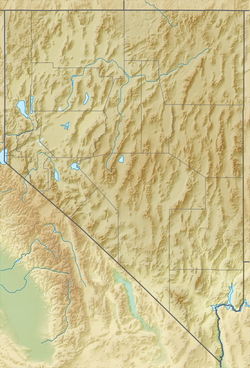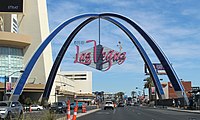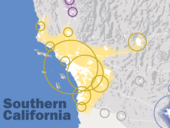Las Vegas
Las Vegas | |
|---|---|
|
| |
| Etymology: from Spanish las vegas 'the meadows' | |
| Nicknames: | |
| Coordinates: 36°10′30″N 115°08′11″W / 36.17500°N 115.13639°W | |
| Country | United States |
| State | Nevada |
| County | Clark |
| Founded | May 15, 1905 |
| Incorporated | March 16, 1911 |
| Government | |
| • Type | Council–manager |
| • Mayor | Carolyn Goodman (I) |
| • Mayor Pro Tem | Brian Knudsen (D) |
| • City council | Members
|
| • City manager | Jorge Cervantes |
| Area | |
| • City | 141.91 sq mi (367.53 km2) |
| • Land | 141.85 sq mi (367.40 km2) |
| • Water | 0.05 sq mi (0.14 km2) |
| Elevation | 2,001 ft (610 m) |
| Population (2020) | |
| • City | 641,903 |
| • Rank | 75th in North America 25th in the United States 1st in Nevada |
| • Density | 4,525.16/sq mi (1,747.17/km2) |
| • Urban | 2,196,623 (US: 21st) |
| • Urban density | 5,046.3/sq mi (1,948.4/km2) |
| • Metro | 2,265,461 (US: 29th) |
| Demonym | Las Vegan |
| GDP | |
| • Las Vegas (MSA) | $160.7 billion (2022) |
| Time zone | UTC−08:00 (PST) |
| • Summer (DST) | UTC−07:00 (PDT) |
| ZIP Codes | 89044, 89054, 891xx |
| Area code | 702 & 725 |
| FIPS code | 32-40000 |
| GNIS feature ID | 847388 |
| Website | lasvegasnevada |
Las Vegas,[a] often known simply as Vegas, is the most populous city in the U.S. state of Nevada and the seat of Clark County. The Las Vegas Valley metropolitan area is the largest within the greater Mojave Desert, and second-largest in the Southwestern United States.[6][7] Las Vegas is an internationally renowned major resort city, known primarily for its gambling, shopping, fine dining, entertainment, and nightlife, with most venues centered on downtown Las Vegas and more to the Las Vegas Strip just outside city limits. The Las Vegas Valley as a whole serves as the leading financial, commercial, and cultural center for Nevada. According to the United States Census Bureau, the city had 641,903 residents in 2020,[8] with a metropolitan population of 2,227,053,[9] making it the 25th-most populous city in the United States.
The city bills itself as the Entertainment Capital of the World, and is famous for its luxurious and extremely large casino-hotels. With over 40.8 million visitors annually as of 2023, Las Vegas is one of the most visited cities in the United States.[10] It is a top-three U.S. destination for business conventions and a global leader in the hospitality industry, claiming more AAA Five Diamond hotels than any other city in the world.[11][12][13] Las Vegas annually ranks as one of the world's most visited tourist destinations.[14][15] The city's tolerance for numerous forms of adult entertainment has earned it the nickname "Sin City",[16] and has made Las Vegas a popular setting for literature, films, television programs, commercials and music videos.
Las Vegas was settled in 1905 and officially incorporated in 1911. At the close of the 20th century, it was the most populated North American city founded within that century (a similar distinction was earned by Chicago in the 19th century). Population growth has accelerated since the 1960s and into the 21st century, and between 1990 and 2000 the population nearly doubled, increasing by 85.2%. As with most major metropolitan areas, the name of the primary city ("Las Vegas" in this case) is often used to describe areas beyond official city limits. In the case of Las Vegas, this especially applies to the areas on and near the Strip, which are actually in the unincorporated communities of Paradise and Winchester.[17][18]
Toponymy
The area was named Las Vegas, which is Spanish for "the meadows", as it featured abundant wild grasses, as well as the desert spring waters needed by westward travelers.[19] The city is often simply called "Vegas".[20][21][22][23][24]
History
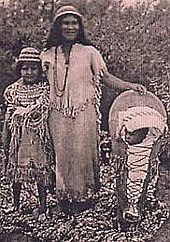
Nomadic Paleo-Indians traveled to the Las Vegas area 10,000 years ago, leaving behind petroglyphs. Ancient Puebloan and Paiute tribes followed at least 2,000 years ago.[25]
A young Mexican scout named Rafael Rivera is credited as the first non-Native American to encounter the valley, in 1829.[26] Trader Antonio Armijo led a 60-man party along the Spanish Trail to Los Angeles, California, in 1829.[27][28] In 1844, John C. Frémont arrived, and his writings helped lure pioneers to the area. Downtown Las Vegas's Fremont Street is named after him.
Eleven years later, members of the Church of Jesus Christ of Latter-day Saints chose Las Vegas as the site to build a fort halfway between Salt Lake City and Los Angeles, where they would travel to gather supplies. The fort was abandoned several years afterward. The remainder of this Old Mormon Fort can still be seen at the intersection of Las Vegas Boulevard and Washington Avenue.
Las Vegas was founded as a city in 1905, when 110 acres (45 ha) of land adjacent to the Union Pacific Railroad tracks were auctioned in what would become the downtown area. In 1911, Las Vegas was incorporated as a city.[29]
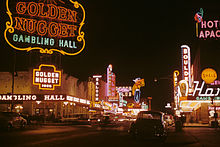
The year 1931 was pivotal for Las Vegas. At that time, Nevada legalized casino gambling and reduced residency requirements for divorce to six weeks. This year also witnessed the beginning of construction on nearby Hoover Dam. The influx of construction workers and their families helped Las Vegas avoid economic calamity during the Great Depression. The construction work was completed in 1935.
In late 1941, Las Vegas Army Airfield was established. Renamed Nellis Air Force Base in 1950, it is now home to the United States Air Force Thunderbirds aerobatic team.[30]
Following World War II, lavishly decorated hotels, gambling casinos, and big-name entertainment became synonymous with Las Vegas.

In 1951, nuclear weapons testing began at the Nevada Test Site, 65 miles (105 km) northwest of Las Vegas. During this time, the city was nicknamed the "Atomic City". Residents and visitors were able to witness the mushroom clouds (and were exposed to the fallout) until 1963 when the Partial Nuclear Test Ban Treaty required that nuclear tests be moved underground.[31]
In 1955, the Moulin Rouge Hotel opened and became the first racially integrated casino-hotel in Las Vegas.
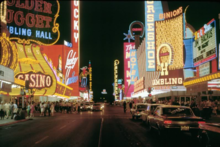
During the 1960s, corporations and business tycoons such as Howard Hughes were building and buying hotel-casino properties. Gambling was referred to as "gaming", which transitioned it into a legitimate business. Learning from Las Vegas, published during this era, asked architects to take inspiration from the city's highly decorated buildings, helping to start the postmodern architecture movement.
In 1995, the Fremont Street Experience opened in Las Vegas's downtown area. This canopied five-block area features 12.5 million LED lights and 550,000 watts of sound from dusk until midnight during shows held at the top of each hour.
Due to the realization of many revitalization efforts, 2012 was dubbed "The Year of Downtown". Projects worth hundreds of millions of dollars made their debut at this time, including the Smith Center for the Performing Arts, the DISCOVERY Children's Museum, the Mob Museum, the Neon Museum, a new City Hall complex, and renovations for a new Zappos.com corporate headquarters in the old City Hall building.[19][32]
Geography

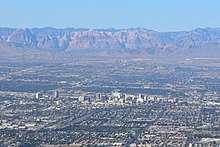
Las Vegas is the county seat of Clark County, in a basin on the floor of the Mojave Desert,[33] and is surrounded by mountain ranges. Much of the landscape is rocky and arid, with desert vegetation and wildlife. It can be subjected to torrential flash floods, although much has been done to mitigate the effects of flash floods through improved drainage systems.[34]
The city's elevation is approximately 2,030 ft (620 m) above sea level, though the surrounding peaks reach elevations of over 10,000 feet (3,000 m) and act as barriers to the strong flow of moisture from the surrounding area. According to the United States Census Bureau, the city has an area of 135.86 sq mi (351.9 km2), of which 135.81 sq mi (351.7 km2) is land and 0.05 sq mi (0.13 km2) (0.03%) is water.
After Alaska and California, Nevada is the third most seismically active state in the U.S. It has been estimated by the United States Geological Survey (USGS) that over the next 50 years, there is a 10–20% chance of an M6.0 or greater earthquake occurring within 50 km (31 mi) of Las Vegas.[35]
Within the city are many lawns, trees, and other greenery. Due to water resource issues, there has been a movement to encourage xeriscapes. Another part of conservation efforts is scheduled watering days for residential landscaping. A U.S. Environmental Protection Agency grant in 2008 funded a program that analyzed and forecast growth and environmental effects through 2019.[36]
Climate

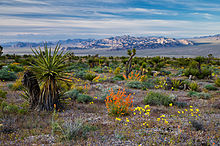
Las Vegas has a subtropical hot desert climate (Köppen climate classification: BWh), typical of the Mojave Desert in which it lies. This climate is typified by long, extremely hot summers; warm transitional seasons; and short winters with mild days and cool nights. There is abundant sunshine throughout the year, with an average of 310 sunny days and bright sunshine during 86% of all daylight hours.[37][38] Rainfall is scarce, with an average of 4.2 in (110 mm) dispersed between roughly 26 total rainy days per year.[39] Las Vegas is among the sunniest, driest, and least humid locations in North America, with exceptionally low dew points and humidity that sometimes remains below 10%.[40]
The summer months of June through September are extremely hot, though moderated by the low humidity levels. July is the hottest month, with an average daytime high of 104.5 °F (40.3 °C). On average, 137 days per year reach or exceed 90 °F (32 °C), of which 78 days reach 100 °F (38 °C) and 10 days reach 110 °F (43 °C). During the peak intensity of summer, overnight lows frequently remain above 80 °F (27 °C), and occasionally above 85 °F (29 °C).[37]
While most summer days are consistently hot, dry, and cloudless, the North American Monsoon sporadically interrupts this pattern and brings more cloud cover, thunderstorms, lightning, increased humidity, and brief spells of heavy rain. Potential monsoons affect Las Vegas between July and August. Summer in Las Vegas is marked by significant diurnal temperature variation. While less extreme than other parts of the state, nighttime lows in Las Vegas are often 30 °F (16.7 °C) or more lower than daytime highs.[41] The average hottest night of the year is 90 °F (32 °C). The all-time record is at 95 °F (35 °C).[37]
Las Vegas winters are relatively short, with typically mild daytime temperatures and chilly nights. Sunshine is abundant in all seasons. December is both the year's coolest and cloudiest month, with an average daytime high of 56.9 °F (13.8 °C) and sunshine occurring during 78% of its daylight hours. Winter evenings are defined by clear skies and swift drops in temperature after sunset, with overnight minima averaging around 40 °F (4.4 °C) in December and January. Owing to its elevation that ranges from 2,000 to 3,000 feet (610 to 910 m), Las Vegas experiences markedly cooler winters than other areas of the Mojave Desert and the adjacent Sonoran Desert that are closer to sea level. The city records freezing temperatures an average of 10 nights per winter. It is exceptionally rare for temperatures to reach or fall below 25 °F (−4 °C).[37]

Most of the annual precipitation falls during the winter. February, the wettest month, averages only four days of measurable rain. The mountains immediately surrounding the Las Vegas Valley accumulate snow every winter, but significant accumulation within the city is rare, although moderate accumulations occur every few years. The most recent accumulations occurred on February 18, 2019, when parts of the city received about 1 to 2 inches (2.5 to 5.1 cm) of snow[42] and on February 20 when the city received almost 0.5 inches (1.3 cm).[43] Other recent significant snow accumulations occurred on December 25, 2015, and December 17, 2008.[44] Unofficially, Las Vegas's largest snowfall on record was the 12 inches (30 cm) that fell in 1909.[45] In recent times, ice days have not occurred, although 29 °F (−2 °C) was measured in 1963.[37] On average the coldest day is 44 °F (7 °C).[37]
The highest temperature officially observed for Las Vegas is 120 °F (48.9 °C), as measured at Harry Reid International Airport on July 7, 2024.[37][46] The lowest temperature was 8 °F (−13 °C), recorded on two days: January 25, 1937, and January 13, 1963.[37] The official record hot daily minimum is 95 °F (35 °C) on July 19, 2005, and July 1, 2013. The official record cold daily maximum is 28 °F (−2 °C) on January 8 and 21, 1937.[37] July 2024 was the hottest month ever recorded in Las Vegas, with its highest recorded mean daily average temperature over the month of 99.9 °F (38 °C), its highest recorded mean daily maximum temperature of 111.5 °F (44 °C), and its highest recorded mean nightly minimum temperature of 88.3 °F (31 °C).[47]
Due to concerns about climate change in the wake of a 2002 drought, daily water consumption has been reduced from 314 US gallons (1,190 L) per resident in 2003 to around 205 US gallons (780 L) in 2015.[48]
| Climate data for Harry Reid International Airport (Paradise, Nevada), 1991–2020 normals,[b] extremes 1937–present | |||||||||||||
|---|---|---|---|---|---|---|---|---|---|---|---|---|---|
| Month | Jan | Feb | Mar | Apr | May | Jun | Jul | Aug | Sep | Oct | Nov | Dec | Year |
| Record high °F (°C) | 77 (25) |
87 (31) |
92 (33) |
99 (37) |
109 (43) |
117 (47) |
120 (49) |
116 (47) |
114 (46) |
104 (40) |
87 (31) |
78 (26) |
120 (49) |
| Mean maximum °F (°C) | 68.7 (20.4) |
74.2 (23.4) |
84.3 (29.1) |
93.6 (34.2) |
101.8 (38.8) |
110.1 (43.4) |
112.9 (44.9) |
110.3 (43.5) |
105.0 (40.6) |
94.6 (34.8) |
80.5 (26.9) |
67.9 (19.9) |
113.6 (45.3) |
| Mean daily maximum °F (°C) | 58.5 (14.7) |
62.9 (17.2) |
71.1 (21.7) |
78.5 (25.8) |
88.5 (31.4) |
99.4 (37.4) |
104.5 (40.3) |
102.8 (39.3) |
94.9 (34.9) |
81.2 (27.3) |
67.1 (19.5) |
56.9 (13.8) |
80.5 (26.9) |
| Daily mean °F (°C) | 49.5 (9.7) |
53.5 (11.9) |
60.8 (16.0) |
67.7 (19.8) |
77.3 (25.2) |
87.6 (30.9) |
93.2 (34.0) |
91.7 (33.2) |
83.6 (28.7) |
70.4 (21.3) |
57.2 (14.0) |
48.2 (9.0) |
70.1 (21.2) |
| Mean daily minimum °F (°C) | 40.5 (4.7) |
44.1 (6.7) |
50.5 (10.3) |
56.9 (13.8) |
66.1 (18.9) |
75.8 (24.3) |
82.0 (27.8) |
80.6 (27.0) |
72.4 (22.4) |
59.6 (15.3) |
47.3 (8.5) |
39.6 (4.2) |
59.6 (15.3) |
| Mean minimum °F (°C) | 29.8 (−1.2) |
32.9 (0.5) |
38.7 (3.7) |
45.2 (7.3) |
52.8 (11.6) |
62.2 (16.8) |
72.9 (22.7) |
70.8 (21.6) |
60.8 (16.0) |
47.4 (8.6) |
35.2 (1.8) |
29.0 (−1.7) |
27.4 (−2.6) |
| Record low °F (°C) | 8 (−13) |
16 (−9) |
19 (−7) |
31 (−1) |
38 (3) |
48 (9) |
56 (13) |
54 (12) |
43 (6) |
26 (−3) |
15 (−9) |
11 (−12) |
8 (−13) |
| Average precipitation inches (mm) | 0.56 (14) |
0.80 (20) |
0.42 (11) |
0.20 (5.1) |
0.07 (1.8) |
0.04 (1.0) |
0.38 (9.7) |
0.32 (8.1) |
0.32 (8.1) |
0.32 (8.1) |
0.30 (7.6) |
0.45 (11) |
4.18 (106) |
| Average snowfall inches (cm) | 0.0 (0.0) |
0.0 (0.0) |
0.0 (0.0) |
0.0 (0.0) |
0.0 (0.0) |
0.0 (0.0) |
0.0 (0.0) |
0.0 (0.0) |
0.0 (0.0) |
0.0 (0.0) |
0.0 (0.0) |
0.2 (0.51) |
0.2 (0.51) |
| Average precipitation days (≥ 0.01 in) | 3.1 | 4.1 | 2.8 | 1.6 | 1.1 | 0.4 | 2.5 | 2.2 | 1.8 | 1.7 | 1.5 | 3.0 | 25.8 |
| Average snowy days (≥ 0.1 in) | 0.0 | 0.1 | 0.0 | 0.0 | 0.0 | 0.0 | 0.0 | 0.0 | 0.0 | 0.0 | 0.0 | 0.1 | 0.2 |
| Average relative humidity (%) | 45.1 | 39.6 | 33.1 | 25.0 | 21.3 | 16.5 | 21.1 | 25.6 | 25.0 | 28.8 | 37.2 | 45.0 | 30.3 |
| Average dew point °F (°C) | 22.1 (−5.5) |
23.7 (−4.6) |
23.9 (−4.5) |
24.1 (−4.4) |
28.2 (−2.1) |
30.9 (−0.6) |
40.6 (4.8) |
44.1 (6.7) |
37.0 (2.8) |
30.4 (−0.9) |
25.3 (−3.7) |
22.3 (−5.4) |
29.4 (−1.5) |
| Mean monthly sunshine hours | 245.2 | 246.7 | 314.6 | 346.1 | 388.1 | 401.7 | 390.9 | 368.5 | 337.1 | 304.4 | 246.0 | 236.0 | 3,825.3 |
| Percent possible sunshine | 79 | 81 | 85 | 88 | 89 | 92 | 88 | 88 | 91 | 87 | 80 | 78 | 86 |
| Source: NOAA (relative humidity, dew point and sun 1961–1990)[37][39][38] | |||||||||||||
Graphs are unavailable due to technical issues. There is more info on Phabricator and on MediaWiki.org. |
See or edit raw graph data.
Nearby communities

- Boulder City, incorporated
- Enterprise, unincorporated
- Henderson, incorporated
- Lone Mountain, unincorporated
- North Las Vegas, incorporated
- Paradise, unincorporated
- Spring Valley, unincorporated
- Summerlin South, unincorporated
- Sunrise Manor, unincorporated
- Whitney, unincorporated
- Winchester, unincorporated
Neighborhoods
Demographics
| Census | Pop. | Note | %± |
|---|---|---|---|
| 1900 | 25 | — | |
| 1910 | 800 | 3,100.0% | |
| 1920 | 2,304 | 188.0% | |
| 1930 | 5,165 | 124.2% | |
| 1940 | 8,422 | 63.1% | |
| 1950 | 24,624 | 192.4% | |
| 1960 | 64,405 | 161.6% | |
| 1970 | 125,787 | 95.3% | |
| 1980 | 164,674 | 30.9% | |
| 1990 | 258,295 | 56.9% | |
| 2000 | 478,434 | 85.2% | |
| 2010 | 583,756 | 22.0% | |
| 2020 | 641,903 | 10.0% | |
| 2022 (est.) | 656,274 | 2.2% | |
| source:[49][50] 2010–2010[8] | |||
| Historical racial profile | 2020[51] | 2010[52] | 2000[53] | 1990[54] | 1970[54] |
|---|---|---|---|---|---|
| White | 46.0% | 62.1% | 69.9% | 78.4% | 87.6% |
| —Non-Hispanic Whites | 40.4% | 47.9% | 58.0% | 72.1% | 83.1%[c] |
| Black or African American | 12.9% | 11.1% | 10.4% | 11.4% | 11.2% |
| Hispanic or Latino (of any race) | 33.3% | 31.5% | 23.6% | 12.5% | 4.6%[c] |
| Asian | 7.2% | 6.1% | 4.8% | 3.6% | 0.7% |
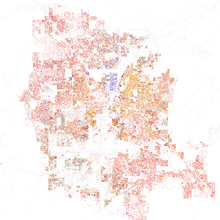
2020 census
This section needs expansion with: examples with reliable citations. You can help by making an edit requestadding to it . (September 2021) |
| Race / Ethnicity (NH = Non-Hispanic) | Pop 2000[55] | Pop 2010[56] | Pop 2020[57] | % 2000 | % 2010 | % 2020 |
|---|---|---|---|---|---|---|
| White alone (NH) | 277,704 | 279,703 | 259,561 | 58.04% | 47.91% | 40.44% |
| Black or African American alone (NH) | 48,380 | 62,008 | 79,129 | 10.11% | 10.62% | 12.33% |
| Native American or Alaska Native alone (NH) | 2,405 | 2,391 | 2,291 | 0.50% | 0.41% | 0.36% |
| Asian alone (NH) | 22,411 | 34,606 | 44,995 | 4.68% | 5.93% | 7.01% |
| Pacific Islander alone (NH) | 1,935 | 3,103 | 4,204 | 0.40% | 0.53% | 0.65% |
| Other race alone (NH) | 650 | 1,101 | 3,855 | 0.14% | 0.19% | 0.60% |
| Mixed race or Multiracial (NH) | 11,987 | 16,985 | 34,040 | 2.51% | 2.91% | 5.30% |
| Hispanic or Latino (any race) | 112,962 | 183,859 | 213,828 | 23.61% | 31.50% | 33.31% |
| Total | 474,434 | 583,756 | 641,903 | 100.00% | 100.00% | 100.00% |
The U.S. Census accounts for race by two methodologies. "Race alone" and "Race alone less Hispanics" where Hispanics are delineated separately as if a separate race.
According to the 2020 U.S. Census, the racial makeup (including Hispanics in the racial counts) was 46.05% (295,594) White alone, 12.85% (82,485) Black alone, 1.14% (7,318) Native American alone, 7.23% (46,398) Asian alone, 0.73% (4,662) Pacific Islander alone, 16.99% (109,045) Other Race alone, and 15.02% (96,401) Multiracial or Mixed Race.[58]
According to the 2020 U.S. Census, the racial and ethnic makeup (where Hispanics are excluded from the racial counts and placed in their own category) was 40.44% (259,561) White alone (non-Hispanic), 12.33% (79,129) Black alone (non-Hispanic), 0.36% (2,291) Native American alone (non-Hispanic), 4.68% (22,411) Asian alone (non-Hispanic), 0.40% (1,935) Pacific Islander alone (non-Hispanic), 0.14% (650) Other Race alone (non-Hispanic), 2.51% (11,987) Multiracial or Mixed Race (non-Hispanic), and 23.61% (112,962) Hispanic or Latino.[57]
2010 census
According to the 2010 Census, the racial composition of Las Vegas was as follows:[59]
- White: 62.1% (Non-Hispanic Whites: 47.9%; Hispanic Whites: 14.2%)
- Black or African American: 11.1%
- Asian: 6.1% (3.3% Filipino, 0.7% Chinese, 0.5% Korean, 0.4% Japanese, 0.4% Indian, 0.2% Vietnamese, 0.2% Thai)
- Two or more races: 4.9%
- Native American: 0.7%
- Native Hawaiian and Other Pacific Islander: 0.6%
Source:[60]
The city's most populous ethnic group, non-Hispanic Whites,[52] have proportionally declined from 72.1% of the population in 1990 to 47.9% in 2010, even as total numbers of all ethnicities have increased with the population. Hispanics or Latinos of any race make up 31.5% of the population. Of those 24.0% are of Mexican, 1.4% of Salvadoran, 0.9% of Puerto Rican, 0.9% of Cuban, 0.6% of Guatemalan, 0.2% of Peruvian, 0.2% of Colombian, 0.2% of Honduran and 0.2% of Nicaraguan descent.[54]
According to research by demographer William H. Frey, using data from the 2010 United States Census, Las Vegas has the second-lowest level of black-white segregation of any of the 100 largest U.S. metropolitan areas, after Tucson, Arizona.[61]
Of the city's Asian residents, according to the city's Asian Chamber of Commerce, Filipinos make up the largest ethnic population within Vegas with over 200,000 in the city.[62][failed verification] Native Hawaiians are also a major demographic in the city, with some Hawaiians and Las Vegas residents calling the city the "ninth island of Hawaii" due to the major influx of Hawaiians to Vegas.[63]
There is an Ethiopian community in Las Vegas.[64][65]
The 2010 census showed the city contained 583,756 people, 211,689 households, and 117,538 families residing.[66] The population density was 4,222.5/sq mi (1,630.3/km2). There were 190,724 housing units at an average density of 1,683.3/sq mi (649.9/km2).
As of 2006, there were 176,750 households, of which 31.9% had children under age 18 living with them, 48.3% were married couples living together, 12.2% had a female householder with no husband present, and 33.5% were non-families. 25.0% of all households were made up of individuals, and 7.5% had someone living alone who was 65 years of age or older. The average household size was 2.66 and the average family size was 3.20.
In the city, the population age distribution was as follows:
- 25.9% under the age of 18
- 8.8% from 18 to 24
- 32.0% from 25 to 44
- 21.7% from 45 to 64
- 11.6% who were 65 years of age or older
The median age was 34 years. For every 100 females, there were 103.3 males. For every 100 females age 18 and over, there were 102.5 males.
The median income for a household in the city was $53,000 and the median income for a family was $58,465.[67] Males had a median income of $35,511 versus $27,554 for females. The per capita income for the city was $22,060. About 6.6% of families and 8.9% of the population were below the poverty line, including 5.4% of those under age 18 and 6.3% of those age 65 or over.
According to a 2004 study, Las Vegas has one of the highest divorce rates.[68][69] The city's high divorce rate is not wholly due to Las Vegans themselves getting divorced. Since divorce is easier in Nevada than in most other states, many people come from across the country for the easier process. Similarly, Nevada marriages are notoriously easy to get. Las Vegas has one of the highest marriage rates of U.S. cities, with many licenses issued to people from outside the area (see Las Vegas weddings).
Economy
The primary drivers of the Las Vegas economy are tourism, gaming, and conventions, which in turn feed the retail and restaurant industries.
Tourism
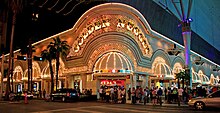


The major attractions in Las Vegas are the casinos and the hotels, although in recent years other new attractions have begun to emerge.
Most casinos in the downtown area are on Fremont Street, with The STRAT Hotel, Casino & Skypod as one of the few exceptions. Fremont East, adjacent to the Fremont Street Experience, was granted variances to allow bars to be closer together, similar to the Gaslamp Quarter of San Diego, the goal being to attract a different demographic than the Strip attracts.
Downtown casinos
The Golden Gate Hotel and Casino, downtown along the Fremont Street Experience, is the oldest continuously operating hotel and casino in Las Vegas; it opened in 1906 as the Hotel Nevada.
In 1931, the Northern Club (now the La Bayou) opened.[70][71] The most notable of the early casinos may have been Binion's Horseshoe (now Binion's Gambling Hall and Hotel) while it was run by Benny Binion.
Boyd Gaming has a major presence downtown operating the California Hotel & Casino, the Fremont Hotel & Casino, and the Main Street Casino. The Four Queens also operates downtown along the Fremont Street Experience.
Downtown casinos that have undergone major renovations and revitalization in recent years include the Golden Nugget Las Vegas, The D Las Vegas (formerly Fitzgerald's), the Downtown Grand Las Vegas (formerly Lady Luck), the El Cortez Hotel & Casino, and the Plaza Hotel & Casino.[72]
In 2020, Circa Resort & Casino opened, becoming the first all-new hotel-casino to be built on Fremont Street since 1980.[73]
Las Vegas Strip
The center of the gambling and entertainment industry is the Las Vegas Strip, outside the city limits in the surrounding unincorporated communities of Paradise and Winchester in Clark County. Some of the largest casinos and buildings are there.[74]
Welcome signs
In 1929, the city installed a welcome arch over Fremont Street, at the corner of Main Street.[75][76][77] It remained in place until 1931.[78][79]
In 1959, the 25-foot-tall (7.6 m) Welcome to Fabulous Las Vegas sign was installed at the south end of the Las Vegas Strip. A replica welcome sign, standing nearly 16 feet (4.9 m) tall, was installed within city limits in 2002, at Las Vegas Boulevard and Fourth Street.[80][81][82] The replica was destroyed in 2016, when a pickup truck crashed into it.[83]
In 2018, the city approved plans for a new gateway landmark in the form of neon arches. It was built within city limits, in front of the Strat resort and north of Sahara Avenue.[84] The project, built by YESCO, cost $6.5 million and stands 80 feet (24 m) high.[85] Officially known as the Gateway Arches, the project was completed in 2020. The steel arches are blue during the day, and light up in a variety of colors at night.[86]
Also located just north of the Strat are a pair of giant neon showgirls, initially added in 2018 as part of a $400,000 welcome display. The original showgirls were 25 feet (7.6 m) tall, but were replaced by new ones in 2022, rising 50 feet (15 m).[87][88] The originals were refurbished following weather damage and installed at the Las Vegas Arts District.[88][89]
Development
When The Mirage opened in 1989, it started a trend of major resort development on the Las Vegas Strip outside of the city. This resulted in a drop in tourism in the downtown area, but many recent projects have increased the number of visitors to downtown.
An effort has been made by city officials to diversify the economy by attracting health-related, high-tech and other commercial interests. No state tax for individuals or corporations, as well as a lack of other forms of business-related taxes, have aided the success of these efforts.[90]
The Fremont Street Experience was built in an effort to draw tourists back to the area and has been popular since its startup in 1995.
The city purchased 61 acres (25 ha) of property from the Union Pacific Railroad in 1995 with the goal of creating a better draw for more people to the downtown area. In 2004, Las Vegas Mayor Oscar Goodman announced plans for Symphony Park, which could include a mixture of offerings, such as residential space and office buildings.
Already operating in Symphony Park is the Cleveland Clinic Lou Ruvo Center for Brain Health (opened in 2010), The Smith Center for the Performing Arts (opened in 2012) and the DISCOVERY Children's Museum (opened in 2013).[91]

On land across from Symphony Park, the World Market Center Las Vegas opened in 2005. It currently encompasses three large buildings with a total of 5.1 million square feet. Trade shows for the furniture and furnishing industries are held there semiannually.
Also nearby is the Las Vegas North Premium Outlets. With a second expansion, completed in May 2015, the mall currently offers 175 stores.[92]
City offices moved to a new Las Vegas City Hall in February 2013 on downtown's Main Street. The former City Hall building is now occupied by the corporate headquarters for the online retailer Zappos.com, which opened downtown in 2013. Zappos CEO Tony Hsieh took an interest in the urban area and contributed $350 million toward a revitalization effort called the Downtown Project.[93][94] Projects funded include Las Vegas's first independent bookstore, The Writer's Block.[95]
Other industries
A number of new industries have moved to Las Vegas in recent decades. Zappos.com (now an Amazon subsidiary) was founded in San Francisco but by 2013 had moved its headquarters to downtown Las Vegas. Allegiant Air, a low-cost air carrier, launched in 1997 with its first hub at Harry Reid International Airport and headquarters in nearby Summerlin.
Planet 13 Holdings, a cannabis company, opened the world's largest cannabis dispensary in Las Vegas at 112,000 sq ft (10,400 m2).[96][97]
Effects of growth on water supply
A growing population means the Las Vegas Valley used 1.2 billion US gal (4.5 billion L) more water in 2014 than in 2011. Although water conservation efforts implemented in the wake of a 2002 drought have had some success, local water consumption remains 30 percent greater than in Los Angeles, and over three times that of San Francisco metropolitan area residents. The Southern Nevada Water Authority is building a $1.4 billion tunnel and pumping station to bring water from Lake Mead, has purchased water rights throughout Nevada, and has planned a controversial $3.2 billion pipeline across half the state. By law, the Las Vegas Water Service District "may deny any request for a water commitment or request for a water connection if the District has an inadequate supply of water." But limiting growth on the basis of an inadequate water supply has been unpopular with the casino and building industries.[48]
Culture
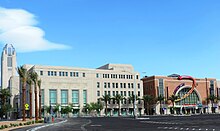
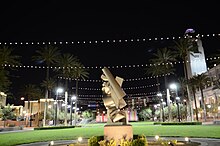
The city is home to several museums, including the Neon Museum (the location for many of the historical signs from Las Vegas's mid-20th century heyday), The Mob Museum, the Las Vegas Natural History Museum, the DISCOVERY Children's Museum, the Nevada State Museum and the Old Las Vegas Mormon Fort State Historic Park.
The city is home to an extensive Downtown Arts District, which hosts numerous galleries and events including the annual Las Vegas Film Festival. "First Friday" is a monthly celebration that includes arts, music, special presentations and food in a section of the city's downtown region called 18b, The Las Vegas Arts District.[98] The festival extends into the Fremont East Entertainment District.[99] The Thursday evening before First Friday is known in the arts district as "Preview Thursday", which highlights new gallery exhibitions throughout the district.[100]
The Las Vegas Academy of International Studies, Performing and Visual Arts is a Grammy award-winning magnet school located in downtown Las Vegas. The Smith Center for the Performing Arts is downtown in Symphony Park and hosts various Broadway shows and other artistic performances.
Las Vegas has earned the moniker "Gambling Capital of the World", as it has the world's most land-based casinos.[101]
Sports

The Las Vegas Valley is the home of three major professional teams: the National Hockey League (NHL)'s Vegas Golden Knights, an expansion team that began play in the 2017–18 NHL season at T-Mobile Arena in nearby Paradise,[102] the National Football League (NFL)'s Las Vegas Raiders, who relocated from Oakland, California, in 2020 and play at Allegiant Stadium in Paradise,[103] and the Women's National Basketball Association (WNBA)'s Las Vegas Aces, who play at the Mandalay Bay Events Center. The Oakland Athletics of Major League Baseball (MLB) plan to move to Las Vegas by 2028.[104][105]
Two minor league sports teams play in the Las Vegas area. The Las Vegas Aviators of the Pacific Coast League, the Triple-A farm club of the Oakland Athletics, play at Las Vegas Ballpark in nearby Summerlin.[106] The Las Vegas Lights FC of the United Soccer League and the Vegas Vipers of the XFL play in Cashman Field in Downtown Las Vegas.[107][108]
The mixed martial arts promotion, Ultimate Fighting Championship (UFC), is headquartered in Las Vegas and also frequently holds fights in the city at T-Mobile Arena and at the UFC Apex training facility near the headquarters.[109]
List of teams
Major professional teams
| Team | Sport | League | Venue (capacity) | Established | Titles |
|---|---|---|---|---|---|
| Las Vegas Raiders | Football | NFL | Allegiant Stadium (65,000) | 2020 | 3[d] |
| Vegas Golden Knights | Ice hockey | NHL | T-Mobile Arena (17,500) | 2017 | 1 |
| Las Vegas Aces | Women's basketball | WNBA | Michelob Ultra Arena (12,000) | 2018 | 2 |
Minor professional teams
| Team | Sport | League | Venue (capacity) | Established | Titles |
|---|---|---|---|---|---|
| Las Vegas Aviators | Baseball | MiLB (AAA-PCL) | Las Vegas Ballpark (10,000) | 1983 | 2 |
| NBA G League Ignite | Basketball | NBAGL | Lee's Family Forum (5,567) | 2020 | 0 |
| Henderson Silver Knights | Ice hockey | AHL | Lee's Family Forum (5,567) | 2020 | 0 |
| Las Vegas Lights FC | Soccer | USLC | Cashman Field (9,334) | 2018 | 0 |
| Vegas Knight Hawks | Indoor football | IFL | Lee's Family Forum (6,019) | 2021 | 0 |
| Las Vegas Desert Dogs | Box lacrosse | NLL | Michelob Ultra Arena (12,000) | 0 |
Semi-pro and amateur teams
| Team | Sport | League | Venue (capacity) | Established | Titles |
|---|---|---|---|---|---|
| Las Vegas Dream | Basketball | ABA | 2023 | ||
| Las Vegas Royals | 2020 | ||||
| Vegas Jesters | Ice hockey | MWHL | City National Arena (600) | 2012 | 0 |
| Las Vegas Thunderbirds | USPHL | 2019 | 0 | ||
| Las Vegas Legends | Soccer | NPSL | Peter Johann Memorial Field (2,500) | 2021 | 0 |
| Vegas NVaders | Women's football | WFA - D2 | Desert Pines High School (N/A) | 2023 | 0 |
College teams
| School | Team | League | Division | Primary Conference |
|---|---|---|---|---|
| University of Nevada, Las Vegas (UNLV) | UNLV Rebels | NCAA | NCAA Division I | Mountain West |
| College of Southern Nevada (CSN) | CSN Coyotes | NJCAA | NJCAA Division I | Scenic West |
Parks and recreation

Las Vegas has 68 parks. The city owns the land for, but does not operate, four golf courses: Angel Park Golf Club, Desert Pines Golf Club, Durango Hills Golf Club, and the Las Vegas Municipal Golf Course. It is also responsible for 123 playgrounds, 23 softball fields, 10 football fields, 44 soccer fields, 10 dog parks, six community centers, four senior centers, 109 skate parks, and six swimming pools.[110]
Government
This section needs additional citations for verification. (May 2017) |
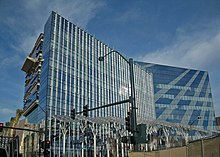
The city of Las Vegas has a council–manager government. The mayor sits as a council member-at-large and presides over all city council meetings. If the mayor cannot preside over a City Council meeting, then the Mayor Pro-Tem is the presiding officer of the meeting until the Mayor returns to his/her seat. The City Manager is responsible for the administration and the day-to-day operations of all municipal services and city departments. The City Manager maintains intergovernmental relationships with federal, state, county and other local governments.
Much of the Las Vegas metropolitan area is split into neighboring incorporated cities or unincorporated communities. Approximately 700,000 people live in unincorporated areas governed by Clark County, and another 465,000 live in incorporated cities such as North Las Vegas, Henderson and Boulder City. Las Vegas and Clark County share a police department, the Las Vegas Metropolitan Police Department, which was formed after a 1973 merger of the Las Vegas Police Department and the Clark County Sheriff's Department. North Las Vegas, Henderson, Boulder City and some colleges have their own police departments.
A Paiute Indian reservation occupies about 1 acre (0.40 ha) in the downtown area.
Las Vegas, home to the Lloyd D. George Federal District Courthouse and the Regional Justice Center, draws numerous companies providing bail, marriage, divorce, tax, incorporation and other legal services.
City council
| Name | Position | Party | References | Notes |
|---|---|---|---|---|
| Carolyn Goodman | Mayor | Independent | [111] | Replaced her husband, Oscar Goodman, who was term-limited |
| Brian Knudsen | 1st Ward Council member | Democratic | [112][113] | Mayor Pro Tem |
| Victoria Seaman | 2nd Ward Council member | Republican | [114][113] | |
| Olivia Diaz | 3rd Ward Council member | Democratic | [115][113] | |
| Francis Allen-Palenske | 4th Ward Council member | Republican | ||
| Cedric Crear | 5th Ward Council member | Democratic | [116][117] | |
| Nancy Brune | 6th Ward Council member | Democratic |
Education
Primary and secondary schools
Primary and secondary public education is provided by the Clark County School District,[118] which is the fifth most populous school district in the nation. Students totaled 314,653 in grades K-12 for school year 2013–2014.[119][not specific enough to verify]
Academic Institutions
The University of Nevada, Las Vegas (UNLV) is the premier academic institution in Southern Nevada and is classified as an R1 research university (R1: Doctoral Universities – Very high research activity). UNLV has a medical school, the Kirk Kerkorian School of Medicine, as well as the only law school in the State of Nevada. UNLV's main campus is an urban campus located about two miles East of the Las Vegas Strip.
The College of Southern Nevada is a community college with one of the largest enrollments in the United States. Also in the Nevada System of Higher Education are Nevada State College and the Desert Research Institute. Touro University Nevada located in Henderson is a non-profit, private institution under Jewish auspices. Other institutions include a number of for-profit private schools (e.g., Le Cordon Bleu College of Culinary Arts, The International Academy of Design & Technology Las Vegas).
Media
Newspapers
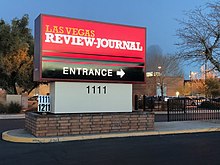
- Las Vegas Review-Journal, the area's largest daily newspaper, is published every morning. It was formed in 1909 but has roots back to 1905. It is the largest newspaper in Nevada and is ranked as one of the top 25 newspapers in the United States by circulation. In 2000, the Review-Journal installed the largest newspaper printing press in the world. It cost $40 million, weighs 910 tons and consists of 16 towers.[120] Until his death in January 2021, the newspaper was owned by casino magnate Sheldon Adelson, who purchased it for $140 million in December 2015. In 2018, the Review-Journal received the Sigma Delta Chi Award from the Society of Professional Journalists for reporting the Oct 1 mass shooting on the Las Vegas Strip. In 2018 and 2022, Editor and Publisher magazine named the Review-Journal as one of 10 newspapers in the United States "doing it right".[121][122]
- Las Vegas Sun, a daily 8-page newspaper independently published but the print edition distributed as a section inside the Review-Journal. The Sun is owned by the Greenspun family and is affiliated with Greenspun Media Group. It was founded independently in 1950 and in 1989 entered into a Joint Operating Agreement with the Review-Journal, which runs through 2040. The Sun has been described as "politically liberal".[123] In 2009, the Sun was awarded a Pulitzer Prize for Public Service for coverage of the high death rate of construction workers on the Las Vegas Strip amid lax enforcement of regulations.
- Las Vegas Weekly is a free alternative weekly newspaper based in Henderson, Nevada. It covers Las Vegas arts, entertainment, culture and news. Las Vegas Weekly was founded in 1992 and is published by Greenspun Media Group.
Broadcast
Las Vegas is served by 22 television stations and 46 radio stations. The area is also served by two NOAA Weather Radio transmitters (162.55 MHz located in Boulder City and 162.40 MHz located on Potosi Mountain).
Magazines
Transportation
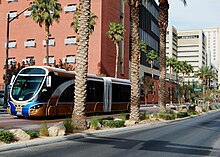


RTC Transit is a public transportation system providing bus service throughout Las Vegas, Henderson, North Las Vegas and other areas of the valley. Inter-city bus service to and from Las Vegas is provided by Greyhound, BoltBus, Orange Belt Stages, Tufesa, and several smaller carriers.[124] Amtrak trains have not served Las Vegas since the service via the Desert Wind at Las Vegas station ceased in 1997, but Amtrak California operates Amtrak Thruway dedicated service between the city and its passenger rail stations in Bakersfield, California, as well as Los Angeles Union Station via Barstow.[125] The high-speed rail project Brightline West, while not in the city, is planned to revive passenger trains between the Las Vegas station and the Rancho Cucamonga station in Greater Los Angeles.
The Las Vegas Monorail on the Strip was privately built, and upon bankruptcy taken over by the Las Vegas Convention and Visitors Authority.
Silver Rider Transit operates three routes within Las Vegas, offering connections to Laughlin,[126] Mesquite,[127] and Sandy Valley.[128]
The Union Pacific Railroad is the only Class I railroad providing rail freight service to the city. Until 1997, the Amtrak Desert Wind train service ran through Las Vegas using the Union Pacific Railroad tracks.
In March 2010, the RTC launched bus rapid transit link in Las Vegas called the Strip & Downtown Express with limited stops and frequent service that connects downtown Las Vegas, the Strip and the Las Vegas Convention Center. Shortly after the launch, the RTC dropped the ACE name.[129]
In 2016, 77.1 percent of working Las Vegas residents (those living in the city, but not necessarily working in the city) commuted by driving alone. About 11 percent commuted via carpool, 3.9 percent used public transportation, and 1.4 percent walked. About 2.3 percent of Las Vegas commuters used all other forms of transportation, including taxi, bicycle, and motorcycle. About 4.3% of working Las Vegas residents worked at home.[130] In 2015, 10.2 percent of city of Las Vegas households were without a car, which increased slightly to 10.5 percent in 2016. The national average was 8.7 percent in 2016. Las Vegas averaged 1.63 cars per household in 2016, compared to a national average of 1.8 per household.
With some exceptions, including Las Vegas Boulevard, Boulder Highway (SR 582) and Rancho Drive (SR 599), the majority of surface streets in Las Vegas are laid out in a grid along Public Land Survey System section lines. Many are maintained by the Nevada Department of Transportation as state highways. The street numbering system is divided by the following streets:
- Westcliff Drive, US 95 Expressway, Fremont Street and Charleston Boulevard divide the north–south block numbers from west to east.
- Las Vegas Boulevard divides the east–west streets from the Las Vegas Strip to near the Stratosphere, then Main Street becomes the dividing line from the Stratosphere to the North Las Vegas border, after which the Goldfield Street alignment divides east and west.
- On the east side of Las Vegas, block numbers between Charleston Boulevard and Washington Avenue are different along Nellis Boulevard, which is the eastern border of the city limits.
Interstates 15, 11, and US 95 lead out of the city in four directions. Two major freeways – Interstate 15 and Interstate 11/U.S. Route 95 – cross in downtown Las Vegas. I-15 connects Las Vegas to Los Angeles, and heads northeast to and beyond Salt Lake City. I-11 goes northwest to the Las Vegas Paiute Indian Reservation and southeast to Henderson and to the Mike O'Callaghan–Pat Tillman Memorial Bridge, where from this point I-11 will eventually continue along US 93 towards Phoenix, Arizona. US 95 (and eventually I-11) connects the city to northwestern Nevada, including Carson City and Reno. US 93 splits from I-15 northeast of Las Vegas and goes north through the eastern part of the state, serving Ely and Wells. US 95 heads south from US 93 near Henderson through far eastern California. A partial beltway has been built, consisting of Interstate 215 on the south and Clark County 215 on the west and north. Other radial routes include Blue Diamond Road (SR 160) to Pahrump and Lake Mead Boulevard (SR 147) to Lake Mead.
East–west roads, north to south[131]
- Ann Road
 Craig Road (SR 573)
Craig Road (SR 573) Cheyenne Avenue (SR 574)
Cheyenne Avenue (SR 574)- Smoke Ranch Road
 Washington Avenue (SR 578)
Washington Avenue (SR 578) Summerlin Parkway (SR 613)
Summerlin Parkway (SR 613) Bonanza Road (SR 579)
Bonanza Road (SR 579) Charleston Boulevard (SR 159)
Charleston Boulevard (SR 159) Sahara Avenue (SR 589)
Sahara Avenue (SR 589)
- North–south roads, west to east
- Fort Apache Road
- Durango Drive
- Buffalo Drive
 Rainbow Boulevard (SR 595)
Rainbow Boulevard (SR 595) Jones Boulevard (SR 596)
Jones Boulevard (SR 596)- Decatur Boulevard
- Valley View Boulevard
 Rancho Drive
Rancho Drive- Maryland Parkway
 Eastern Avenue (SR 607)
Eastern Avenue (SR 607)- Pecos Road
 Lamb Boulevard (SR 610)
Lamb Boulevard (SR 610) Nellis Boulevard (SR 612)
Nellis Boulevard (SR 612)
Harry Reid International Airport handles international and domestic flights into the Las Vegas Valley. The airport also serves private aircraft and freight/cargo flights. Most general aviation traffic uses the smaller North Las Vegas Airport and Henderson Executive Airport.
Notable people
See also
- 2017 Las Vegas shooting
- List of films set in Las Vegas
- List of films shot in Las Vegas
- List of Las Vegas casinos that never opened
- List of mayors of Las Vegas
- List of television shows set in Las Vegas
- Radio stations in Las Vegas
- Television stations in Las Vegas
Notes
- ^
- American English: /lɑːs ˈveɪɡəs/ lahss VAY-gəss
- Spanish: [laz ˈβeɣas], lit. 'The Meadows'
- ^ Mean monthly maxima and minima (i.e. the highest and lowest temperature readings during an entire month or year) calculated based on data at said location from 1991 to 2020.
- ^ a b From 15% sample
- ^ Two titles were won when the team was based in Oakland, California and one was won during the team's time in Los Angeles, California.
References
- ^ "Words and Their Stories: Nicknames for New Orleans and Las Vegas". VOA News. March 13, 2010. Archived from the original on April 25, 2016. Retrieved January 29, 2012.
- ^ Lovitt, Rob (December 15, 2009). "Will the real Las Vegas please stand up?". NBC News. Retrieved February 4, 2012.
- ^ "ArcGIS REST Services Directory". United States Census Bureau. Archived from the original on October 11, 2014. Retrieved September 19, 2022.
- ^ "2020 Population and Housing State Data". United States Census Bureau. Archived from the original on August 24, 2021. Retrieved August 22, 2021.
- ^ "Total Gross Domestic Product for Las Vegas-Henderson-Paradise, NV (MSA)". fred.stlouisfed.org.
- ^ "Find a County". National Association of Counties. Archived from the original on May 31, 2011. Retrieved June 7, 2011.
- ^ Brunn, S.D.; Zeigler, D.J.; Hays-Mitchell, M.; Graybill, J.K. (2020). Cities of the World: Regional Patterns and Urban Environments. Rowman & Littlefield Publishers. p. 29. ISBN 978-1-5381-2635-6. Retrieved March 23, 2023.
- ^ a b "QuickFacts: Las Vegas city, Nevada". United States Census Bureau. Archived from the original on March 14, 2022. Retrieved August 22, 2021.
- ^ "Profile of General Population and Housing Characteristics: 2010 Demographic Profile Data (DP-1): Las Vegas city, Nevada". United States Census Bureau. Archived from the original on July 9, 2021. Retrieved March 9, 2012.
- ^ "Vegas in 2023: Strength in Numbers", Travel Weekly, February 20, 2024
- ^ Jones, Charisse (August 21, 2013). "Top convention destinations: Orlando, Chicago, Las Vegas". USA Today. Archived from the original on April 11, 2019. Retrieved September 2, 2017.
- ^ Trejos, Nancy (January 17, 2014). "AAA chooses Five Diamond hotels, restaurants for 2014". USA Today. Retrieved January 10, 2015.
- ^ "Top 5 Cities to Get Hired in Hospitality". Hcareers. Archived from the original on January 14, 2016. Retrieved January 10, 2015.
- ^ "Overseas Visitation Estimates for U.S. States, Cities, and Census Regions: 2013" (PDF). International Visitation in the United States. US Office of Travel and Tourism Industries, US Department of Commerce. May 2014. Archived from the original (PDF) on November 13, 2018. Retrieved December 14, 2014.
- ^ "World's Most-Visited Tourist Attractions". Travel + Leisure. November 10, 2014. Archived from the original on September 15, 2012. Retrieved January 10, 2015.
- ^ Schwartz, David G. (December 10, 2018). "Why Las Vegas Is Still America's Most Sinful City". Forbes. Retrieved August 27, 2019.
- ^ Schoenmann, Joe (February 3, 2010). "Vegas not alone in wanting in on .vegas". Las Vegas Sun. Archived from the original on August 29, 2012. Retrieved April 5, 2011.
- ^ "Clark County 100 in 2009,Announces Plans" (PDF) (Press release). Clark County, Nevada. October 22, 2008. Archived (PDF) from the original on May 28, 2022. Retrieved May 28, 2022.
The Las Vegas Strip is in unincorporated Clark County and not in any city.
- ^ a b "History". City of Las Vegas. Archived from the original on July 1, 2014. Retrieved December 2, 2016.
- ^ Pelloux, Cécilia (June 30, 2018). "5 Things To Experience On A Road Trip In West America". Forbes. Retrieved September 27, 2023.
- ^ Pastras, Philip (2001). Dead Man Blues: Jelly Roll Morton way out West. University of California Press Center for Black Music Research, Columbia College Chicago. p. 40. ISBN 0520236874. Retrieved September 28, 2023.
- ^ Flaherty, Bryan (November 27, 2021). "Twitter welcomes the NHL's newest franchise, the Vegas Golden Knights, by roasting it". Washington Post. Retrieved September 27, 2023.
- ^ Moehring, Eugene P. (March 16, 2005). Las Vegas: A Centennial History. University of Nevada Press. ISBN 0874176476.
- ^ Merriam Webster's Geographical Dictionary (3rd ed.). Merriam-Webster. 1997. p. 633. ISBN 978-0877795469.
- ^ Cordell, Linda (1994). Ancient Pueblo Peoples. St. Remy Press and Smithsonian Institution. pp. 18–19. ISBN 0-89599-038-5.
- ^ Land, Barbara; Land, Myrick (March 1, 2004). A Short History of Las Vegas. University of Nevada Press. p. 4. ISBN 978-0874176438. Retrieved December 18, 2020.
- ^ "FAQs/History". Clark County, Nevada. Archived from the original on December 1, 2010. Retrieved December 4, 2008.
- ^ Ponce, Victor Miguel. "Las Vegas, how did Las Vegas get its name, groundwater depletion". San Diego State University. Retrieved September 13, 2014.
- ^ Federal Writers' Project (1941). Origin of Place Names: Nevada (PDF). Works Progress Administration. p. 16. Archived (PDF) from the original on April 9, 2018.
- ^ "Home". United States Air Force Thunderbirds. Archived from the original on October 20, 2019. Retrieved October 25, 2019.
- ^ a b Simon, Steven; Bouville, Andre (January–February 2006). "Fallout from Nuclear Weapons Tests and Cancer Risks". American Scientist. 94 (1): 48. doi:10.1511/2006.57.48. ISSN 0003-0996. Archived from the original on July 9, 2014. Retrieved December 18, 2020.
Exposures 50 years ago still have health implications today that will continue into the future...Deposition...generally decreases with distance from the test site in the direction of the prevailing wind across North America, although isolated locations received significant deposition as a result of rainfall. Trajectories of the fallout debris clouds across the U.S. are shown for four altitudes. Each dot indicates six hours.
- ^ Segall, Eli; Subrina Hudson (October 22, 2020). "Zappos' new landlord is a familiar face". Las Vegas Review-Journal. Archived from the original on November 28, 2020. Retrieved December 18, 2020.
- ^ "Geography of Las Vegas, Nevada". geography.about.com. Archived from the original on April 12, 2014. Retrieved February 25, 2014.
- ^ "Flood control a success". Las Vegas Review-Journal. December 28, 2010. Retrieved September 13, 2014.
- ^ "Loss-Estimation Modeling of Earthquake Scenarios for Each County in Nevada Using HAZUS-MH" (PDF). Nevada Bureau of Mines and Geology. Nevada Bureau of Mines and Geology/University of Nevada, Reno. February 23, 2006. p. 65. Archived (PDF) from the original on September 10, 2015. Retrieved March 27, 2016.
"Probability of an earthquake of magnitude 6.0 or greater occurring within 50 km in 50 years (from USGS probabilistic seismic hazard analysis) 10–20% chance for Las Vegas area, magnitude 6".
- ^ "Las Vegas Xeriscaping & Desert Landscaping Tips - Modern Landscape Las Vegas". April 6, 2015. Retrieved August 15, 2024.
- ^ a b c d e f g h i j "NowData – NOAA Online Weather Data". National Oceanic and Atmospheric Administration. Archived from the original on July 21, 2021. Retrieved October 11, 2021.
- ^ a b "WMO Climate Normals for LAS VEGAS/MCCARRAN, NV 1961–1990". National Oceanic and Atmospheric Administration. Archived from the original on August 3, 2023. Retrieved October 11, 2021.
- ^ a b "Summary of Monthly Normals 1991–2020". National Oceanic and Atmospheric Administration. Archived from the original on August 3, 2023. Retrieved October 11, 2021.
- ^ Osborn, Liz. "Cities With Low Humidity in the USA". Current Results. Archived from the original on October 19, 2016. Retrieved December 18, 2020.
- ^ Sauceda, Daniel O. (December 2014). Observed and Simulated Urban Heat Island and Urban Cool Island in Las Vegas (PDF) (Thesis). University of Nevada, Reno. Archived (PDF) from the original on November 13, 2018. Retrieved December 18, 2020.
- ^ Montero, David. "It just snowed in Vegas and likely will again this week. That isn't normal". Los Angeles Times.
- ^ NWS Las Vegas [@NWSVegas] (February 21, 2019). "Las Vegas official snowfall for Feb 20th is 0.5 inches. This breaks a daily snowfall record for this date" (Tweet). Retrieved July 20, 2019 – via Twitter.
- ^ Michor, Max (February 23, 2018). "Las Vegas Valley gets first touch of white winter". Las Vegas Review-Journal. Archived from the original on October 7, 2019. Retrieved July 20, 2019.
- ^ Hansen, Kyle B. (August 26, 2011). "Photos: Remembering snowstorms in Las Vegas offers retreat from the heat". Las Vegas Sun. Archived from the original on July 20, 2019. Retrieved July 20, 2019.
- ^ National Weather Service Las Vegas [@NWSVegas] (July 7, 2024). "Well, it managed to hit 120° at Harry Reid Airport. #nvwx" (Tweet). Retrieved July 8, 2024 – via Twitter.
- ^ "Almanac for Las Vegas Area, NV (ThreadEx) - July 31, 2024". National Weather Service. August 1, 2024. Archived from the original on June 16, 2022. Retrieved August 2, 2024.
- ^ a b Lustgarten, Abrahm (June 2, 2015). "Las Vegas Water Chief Pat Mulroy Preached Conservation, But Pushed Growth". ProPublica. Archived from the original on June 2, 2015. Retrieved November 18, 2019.
- ^ "Geographic Identifiers: 2010 Demographic Profile Data (G001): Las Vegas city, Nevada; count revision of 01-07-2018". United States Census Bureau. Archived from the original on July 9, 2021. Retrieved March 9, 2018.
- ^ Moffatt, Riley. Population History of Western U.S. Cities & Towns, 1850–1990. Lanham: Scarecrow, 1996, 159.
- ^ "2020 census".
- ^ a b "Las Vegas (city), Nevada". State & County QuickFacts. U.S. Census Bureau. Archived from the original on February 18, 2009. Retrieved April 20, 2012.
- ^ "Race and Hispanic or Latino: 2000". U.S. Census Bureau. Archived from the original on October 25, 2016. Retrieved November 30, 2018.
- ^ a b c "Nevada – Race and Hispanic Origin for Selected Cities and Other Places: Earliest Census to 1990". U.S. Census Bureau. Archived from the original on August 12, 2012. Retrieved April 20, 2012.
- ^ "P004: Hispanic or Latino, and Not Hispanic or Latino by Race – 2000: DEC Summary File 1 – Las Vegas city, Nevada". United States Census Bureau. Retrieved January 26, 2024.
- ^ "P2: Hispanic or Latino, and Not Hispanic or Latino by Race – 2010: DEC Redistricting Data (PL 94-171) – Las Vegas city, Nevada". United States Census Bureau. Retrieved January 26, 2024.
- ^ a b "P2: Hispanic or Latino, and Not Hispanic or Latino by Race – 2020: DEC Redistricting Data (PL 94-171) – Las Vegas city, Nevada". United States Census Bureau. Retrieved January 26, 2024.
- ^ "P1: Race – 2020: DEC Redistricting Data (PL 94-171) – Las Vegas city, Nevada". United States Census Bureau.
- ^ "Data Access and Dissemination Systems (DADS)". United States Census Bureau. Archived from the original on July 9, 2021. Retrieved September 13, 2014.
- ^ "Las Vegas, Nevada 2010 Census Profile". USA Today. Archived from the original on May 1, 2011. Retrieved April 21, 2011.
- ^ Frey, William H. (July 24, 2018). Diversity Explosion: How New Racial Demographics Are Remaking America (Second ed.). Washington, D.C.: Brookings Institution Press. p. 177. ISBN 978-0-8157-2398-1. Retrieved December 18, 2020.
- ^ "Filipinos are largest AAPI group in Las Vegas". Channel 13 Las Vegas News KTNV. May 14, 2021. Retrieved October 3, 2023.
- ^ "Las Vegas: Bright Lights, Big City, Small Town". State of the Reunion. Autumn 2012. Archived from the original on June 2, 2013. Retrieved July 5, 2013.
- ^ "Little Ethiopia seeks recognition as cultural district". December 17, 2019.
- ^ Simich, Jerry L.; Wright, Thomas C. (March 15, 2010). More Peoples of Las Vegas: One City, Many Faces. University of Nevada Press. ISBN 9780874178180.
- ^ "Las Vegas, Nevada Census 2010 and 2000 Interactive Map, Demographics, Statistics, Quick Facts". Census Viewer. Archived from the original on November 24, 2020. Retrieved December 18, 2020.
- ^ "Income in the Past 12 Months (In 2006 Inflation-Adjusted Dollars): Las Vegas". U.S. Census Bureau. Archived from the original on February 12, 2020. Retrieved December 18, 2020.
- ^ "Most Stressful US City". City Mayors. January 10, 2004. Archived from the original on September 1, 2009. Retrieved July 13, 2009.
- ^ Blakeslee, Sandra (December 16, 1997). "Health: Suicide Rate Higher in 3 Gambling Cities, Study Says". The New York Times. Retrieved July 13, 2009.
- ^ Rinella, Heidi Knapp (July 27, 2000). "New book raises questions about Silver State". Las Vegas Review-Journal.
- ^ "Fremont Street Experience Brings Downtown Las Vegas into Next Century". Fremont Street Experience. Archived from the original on March 10, 2009. Retrieved December 8, 2008.
- ^ 2013 Fiscal Year in Review, city of Las Vegas Economic and Urban Development Projects, "A New Downtown Emerges."
- ^ Katsilometes, John (January 10, 2019). "Circa is Las Vegas pioneer Derek Stevens' chosen title". Las Vegas Review-Journal. Archived from the original on August 13, 2024. Retrieved August 22, 2019.
- ^ Koch, Ed; Manning, Mary; Toplikar, Dave (May 15, 2008). "Showtime: How Sin City evolved into 'The Entertainment Capital of the World'". Las Vegas Sun. Archived from the original on March 6, 2019. Retrieved March 3, 2019.
- ^ "Great 'Welcome' Arch Planned For Officials". Las Vegas Age. June 13, 1929. p. 1. Retrieved December 11, 2023.
- ^ "Welcome Arch Material Fund Grows Rapidly". Las Vegas Age. June 15, 1929. p. 1. Retrieved December 11, 2023.
- ^ "Put a Star on It: A Brief History of the Welcome Sign". Neon Museum. January 2, 2019. Retrieved December 11, 2023.
- ^ "Welcome Arch Will be Razed". Las Vegas Review-Journal. April 2, 1931. Retrieved December 11, 2023.
- ^ "Welcome Arch is Razed Last Eve". Las Vegas Review-Journal. April 4, 1931. Retrieved December 11, 2023.
- ^ "The Other Las Vegas". Las Vegas Review-Journal. December 4, 2002. Archived from the original on September 8, 2005.
- ^ Brown, Patricia Leigh (January 13, 2005). "A Neon Come-Hither, Still Able to Flirt". The New York Times. Retrieved December 18, 2020.
- ^ "Ask Mr. Sun: The Welcome to Fabulous Las Vegas sign". Las Vegas Sun. November 25, 2008. Archived from the original on March 23, 2021. Retrieved December 11, 2023.
- ^ Michor, Max (July 17, 2016). "'Welcome to Fabulous Downtown Las Vegas' sign destroyed by truck". Las Vegas Review-Journal. Archived from the original on December 11, 2023. Retrieved December 11, 2023.
- ^ Akers, Mick (May 18, 2018). "Neon arches to welcome visitors to downtown Las Vegas". Las Vegas Sun. Retrieved December 11, 2023.
- ^ Akers, Mick (March 2, 2020). "Downtown Las Vegas gateway arch construction to start this month". Las Vegas Review-Journal. Retrieved December 11, 2023.
- ^ Forgione, Mary (November 19, 2020). "Can Sin City's new Gateway Arches outshine the Welcome to Las Vegas sign?". Los Angeles Times. Archived from the original on January 1, 2024. Retrieved December 11, 2023.
- ^ Lane, Taylor (August 2, 2022). "50-foot showgirls coming to north Strip". Las Vegas Review-Journal. Retrieved December 11, 2023.
- ^ a b Garcia, Tony (August 31, 2022). "Pair of 50-foot-tall showgirls make downtown debut". Las Vegas Review-Journal. Retrieved December 11, 2023.
- ^ "25-foot-tall showgirls relocated to Las Vegas Arts District gateway". KSNV. March 14, 2023. Retrieved December 11, 2023.
- ^ "Las Vegas Redevelopment Agency". City of Las Vegas. Archived from the original on May 4, 2016. Retrieved December 18, 2020.
- ^ "Symphony Park, Las Vegas". Las Vegas Economic and Urban Development Agency. June 18, 2014. Archived from the original on April 15, 2016. Retrieved April 8, 2016.
- ^ "Premium Outlets: Las Vegas". Simon Property Group. Archived from the original on October 12, 2014. Retrieved September 13, 2014.
- ^ "Downtown Project – Revitalizing Downtown Las Vegas". Downtownproject.com. Retrieved September 13, 2014.
- ^ Pratt, Timothy (October 19, 2012). "What Happens in Brooklyn Moves to Vegas". The New York Times Magazine. Retrieved December 18, 2020.
- ^ Sieroty, Chris. "Despite E-Books, Independent Bookstore Gambling on Downtown Las Vegas". KNPR News. Archived from the original on May 30, 2015. Retrieved December 18, 2020.
- ^ Im, Jimmy (November 3, 2018). "The world's largest cannabis dispensary just opened in Vegas—and it has an entertainment complex attached". CNBC. Archived from the original on June 24, 2019. Retrieved June 25, 2019.
- ^ Chen, Angela (November 15, 2018). "We visited the world's largest cannabis dispensary". The Verge. Archived from the original on June 24, 2019. Retrieved December 18, 2020.
- ^ "18b Las Vegas Art District". 18b.org. Archived from the original on September 26, 2014. Retrieved September 13, 2014.
- ^ "First Friday Main Menu". First Friday Las Vegas Network. Archived from the original on July 15, 2014. Retrieved September 13, 2014.
- ^ "Preview Thursday less hectic than First Friday art event". Las Vegas Review-Journal. May 22, 2013. Archived from the original on July 24, 2022. Retrieved July 24, 2022.
- ^ "Las Vegas Gambling Capital". vegasmobilecasino.co.uk. August 31, 2016. Retrieved September 5, 2017.
- ^ Rosen, Dan (June 22, 2016). "Las Vegas awarded NHL franchise". NHL.com. NHL Enterprises, L.P. Retrieved May 20, 2022.
- ^ Rosenthal, Gregg (March 27, 2017). "NFL owners approve Raiders' move to Las Vegas". NFL.com. NFL Enterprises, LLC. Archived from the original on July 5, 2023. Retrieved May 20, 2022.
- ^ "Oakland A's close in on move to Las Vegas after signing land deal for stadium". The Guardian. April 20, 2023. ISSN 0261-3077. Archived from the original on July 22, 2023. Retrieved April 20, 2023.
- ^ DUBOW, JOSH (April 20, 2023). "Oakland A's purchase land for new stadium in Las Vegas". SFGATE. Archived from the original on April 26, 2023. Retrieved April 20, 2023.
- ^ Bowers, Nikki (April 17, 2018). "Las Vegas 51s to rebrand, rename team". KLAS News. Archived from the original on April 18, 2018. Retrieved April 18, 2018.
- ^ "Las Vegas Lights FC". www.lasvegaslightsfc.com. Archived from the original on May 1, 2018. Retrieved October 24, 2018.
- ^ "Home". United Soccer League.
- ^ "UFC Apex Officially Opens in Las Vegas". UFC.com. June 18, 2019. Archived from the original on April 16, 2021. Retrieved April 15, 2021.
- ^ "Find Parks and Facilities". City of Las Vegas. Archived from the original on January 9, 2015. Retrieved January 10, 2015.
- ^ "2011 Municipal Primary Election April 5, 2011". Clark County, Nevada. April 5, 2011. Archived from the original on June 12, 2011. Retrieved June 14, 2011.
- ^ "Brian Knudsen". LGBTQ Victory Fund. Archived from the original on July 20, 2019. Retrieved July 20, 2019.
- ^ a b c Wilson, Miranda (July 3, 2019). "Diverse new members sworn in to Las Vegas City Council". Las Vegas Sun. Retrieved July 20, 2019.
- ^ Willson, Miranda (June 11, 2019). "Knudsen, Diaz and Seaman win races, reshaping the Las Vegas City Council". Las Vegas Sun. Retrieved July 20, 2019.
- ^ Valley, Jackie (June 11, 2019). "Diaz, Knudsen and Seaman to join Las Vegas City Council after winning municipal races". The Nevada Independent. Retrieved July 20, 2019.
- ^ "Cedric Crear". Ballotpedia. Retrieved May 11, 2019.
- ^ Searer, Kirsten (April 2, 2004). "At least four vie for Neal seat". Las Vegas Sun. Archived from the original on May 12, 2019. Retrieved May 11, 2019.
- ^ "2020 census - school district reference map: Clark County, NV" (PDF). U.S. Census Bureau. Archived (PDF) from the original on July 23, 2022. Retrieved July 23, 2022. - Text list Archived July 23, 2022, at the Wayback Machine
- ^ Source: city of Las Vegas Planning Department, MAY 2014.
- ^ Scheid, Jenny. "New presses are the worlds's largest". Las Vegas Review-Journal. Retrieved August 6, 2018.
- ^ Yang, Nu; Ruiz, Jesus. "10 Newspapers That Do It Right 2018: Recognizing Success in Pioneering Newsrooms, Advertising Growth and Community Engagement". Editor & Publisher. Archived from the original on August 16, 2018. Retrieved December 18, 2020.
- ^ Blinder, Robin (March 1, 2022). "10 news publishers that do it right". Editor & Publisher. Retrieved September 4, 2022.
- ^ Rainey, James. "Sleeping with the enemy newspaper". Los Angeles Times. p. E1. Retrieved March 8, 2006.
- ^ "Nevada Tables". American Intercity Bus Riders Association. Archived from the original on April 26, 2015. Retrieved July 23, 2016.
- ^ "California-Train and Thruway service" (PDF). Amtrak. Archived (PDF) from the original on August 13, 2012. Retrieved June 18, 2013.
- ^ "Laughlin Express Flyer" (PDF). Southern Nevada Transit Coalition. Archived (PDF) from the original on May 7, 2022. Retrieved April 11, 2022.
- ^ "Mesquite Express Brochure" (PDF). Southern Nevada Transit Coalition. Archived (PDF) from the original on April 16, 2021. Retrieved April 11, 2022.
- ^ "Sandy Valley & Goodsprings Express route" (PDF). Southern Nevada Transit Coalition. Archived (PDF) from the original on April 18, 2022. Retrieved April 11, 2022.
- ^ Green, Steve (August 17, 2011). "Lawsuit prompts RTC to drop 'ACE' name from bus lines". Las Vegas Sun. Archived from the original on December 9, 2010. Retrieved March 1, 2011.
- ^ "Means of Transportation to Work by Age". Census Reporter. Retrieved May 6, 2018.
- ^ Most arterial roads are shown, as indicated on the Nevada Department of Transportation's Roadway functional classification: Las Vegas urbanized area map Archived April 4, 2012, at the Wayback Machine. Retrieved November 12, 2011.
Further reading
- Brigham, Jay. "Review: 'Reno, Las Vegas, and the Strip: A Tale of Three Cities'." Western Historical Quarterly 46.4 (2015): 529–530. JSTOR westhistquar.46.4.0529.
- Chung, Su Kim (2012). Las Vegas Then and Now, Holt: Thunder Bay Press, ISBN 978-1-60710-582-4
- Moehring, Eugene P. Resort City in the Sunbelt: Las Vegas, 1930–2000 (2000).
- Moehring, Eugene, "The Urban Impact: Towns and Cities in Nevada's History", Nevada Historical Society Quarterly 57 (Fall/Winter 2014): 177–200.
- Rowley, Rex J. Everyday Las Vegas: Local Life in a Tourist Town (2013)
- Stierli, Martino (2013). Las Vegas in the Rearview Mirror: The City in Theory, Photography, and Film, Los Angeles: Getty Publications, ISBN 978-1-60606-137-4
- Venturi, Robert (1972). Learning from Las Vegas: The Forgotten Symbolism of Architectural Form, Cambridge: MIT Press, ISBN 978-0-26272-006-9













